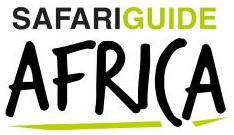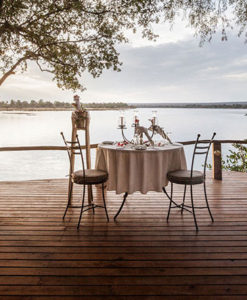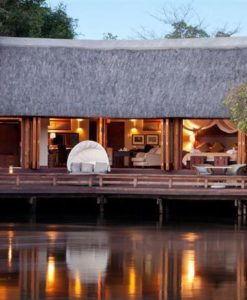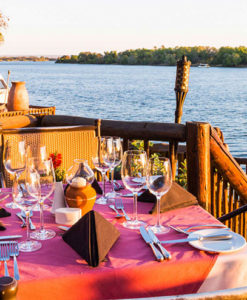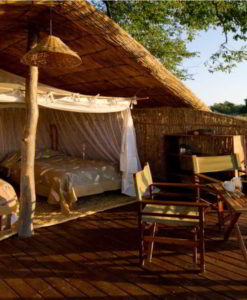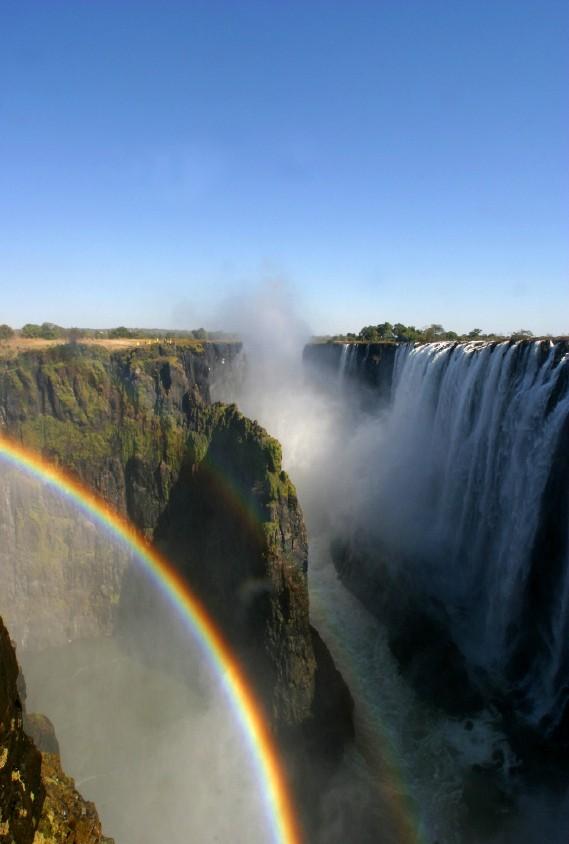Between Zambia and Zimbabwe lies Victoria Falls, a near-solid sheet of water measuring a width of 1708 meters (5604 ft) and a height of 108 meters, making it the largest single sheet of flowing water in the world. It is one of the 7 Natural Wonders of the World and is located almost exactly halfway along the mighty Zambezi River’s 2700 kilometer/1700 mile journey from its source to the sea.
The Scottish explorer David Livingstone was the first European to discover the falls in 1855, naming them after the British queen. The indigenous Kololo tribe have however always christened the falls Mosi-oa-Tunya, meaning the “Smoke that Thunders.”
Featured Victoria Falls Safari Lodges
Featured Victoria Falls Safari Packages
Today Victoria Falls attracts travelers not only to view the immense waterfall but also to experience the surrounding adventure scene. Victoria Falls also acts as a regional connecting point to Chobe National Park and the Okavango Delta in Botswana.
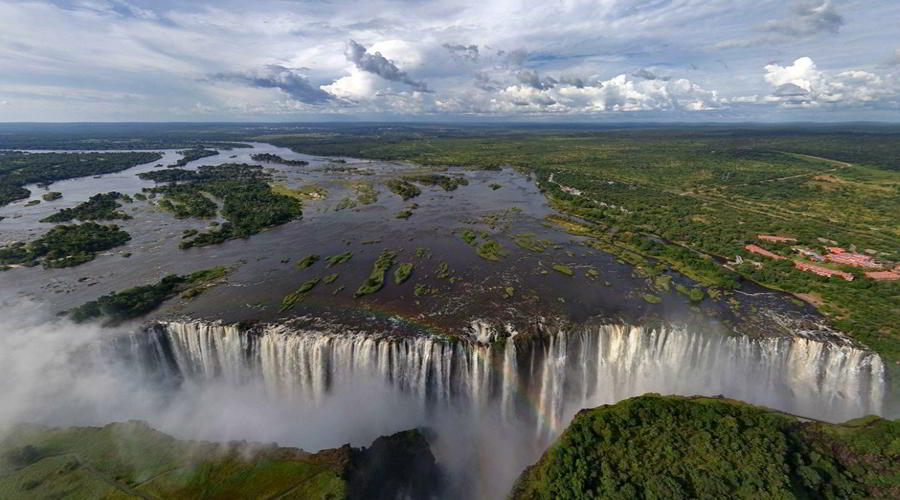
NATIONAL PARKS AND WILDLIFE
Victoria Falls and its fauna and flora are protected by two national parks: The Mosi-oa-Tunya National Park in Zambia, and the Victoria Falls National Park on the Zimbabwean side. The Zambezi National Park runs west along the river and shares a border with the Victoria Falls National Park. Combined these two parks cover an area of 56000 hectares and host a wide variety of wildlife including the Big 5.
The Zambezi River accommodates 39 species of fish below the falls and 89 above, in addition to its fleet of hippo and crocodile. The Zambezi is mainly known for its tiger fishing. The tigerfish is often regarded as Africa’s answer to South America’s piranha, although they are not in the same zoological family, and is seen by most as the best freshwater game fish on the continent.
The rainforest that grows in the spray of the falls also plays host to unique fauna and flora, as well as small mammals. Commonly found beneath the forest canopy of Date Palm, Fig and Mahogany trees are vervet monkeys and baboons.
Animal movement is restricted by fences in the Mosi-oa-Tunya National Park, located on the upper Zambezi. It is a relatively small park at only 66 square kilometers (16309 acres). There are no predators in the park, but resident animals such as zebra, giraffe, sable, buffalo, eland, impala, and warthog are quite relaxed due to their exposure to vehicles, making for ideal photographic opportunities.
ADVENTURE
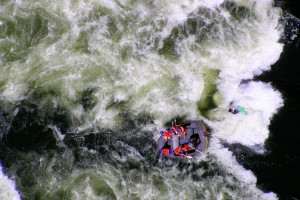
Victoria Falls is southern Africa’s adventure capital. White Water Rafting is extremely popular on both the Zimbabwean and Zambian sides. The Zambian side does offer a lift out, but those on the Zimbabwean side will have to climb. The best time to do White Water Rafting is when the water levels are low. Rafting is entirely dependent on the rainfall, but in general, the river runs low from September to January. No river rafting is allowed when the water is too high.
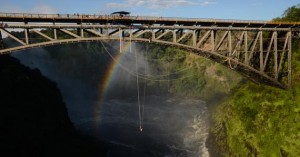 Adrenaline seekers can do a bungee jump near the falls. The jump is done from the bridge between Zambia and Zimbabwe and is a stomach-clenching 111 meter/364 foot drop into the gorge.
Adrenaline seekers can do a bungee jump near the falls. The jump is done from the bridge between Zambia and Zimbabwe and is a stomach-clenching 111 meter/364 foot drop into the gorge.
Livingstone Island tours are becoming increasingly popular. David Livingstone famously saw the falls for the first time from this spot, and it is only accessible from Zambia. Twin engine boats ferry visitors over to the island where some of the best views of the falls are. Only 16 guests can visit the island at one time, and only five daily visits are made to preserve the natural habitat.
Guided tours are offered to guests who wish to learn more about the site: from its ancient roots as a sacrificial site to modern day World Heritage status. All visits to the island are done only during low water season, which usually runs from mid-July to end January.
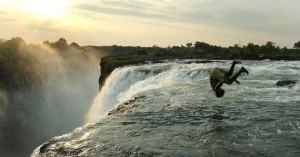
Visitors who want to experience the falls in the most exciting and up-close way can visit Devil’s Pool, a natural rock pool that is safe enough to swim in during the dry season and thrillingly close to the falls’ edge. Here you can swim to the edge of the falls before the water plummets 100 meters/300 feet to the rocks below. The natural rock wall protects adventurers from being swept away.
The Lion Encounter is another exciting activity for those interested in wildlife. Guests on either side of the falls can walk with lions from ages 3 to 16 months. Persons under 1.5 meters tall or under 16 years of age are unfortunately not permitted to participate.
The above outlines a sample of activities, although the list is by no means complete. Other options range from sunset cruises and Chobe National Park day visits to cultural and historical outings.
WHICH SIDE TO CHOOSE
Travelers will get the best views of the falls from the Zimbabwean side, but better quality hotels on the Zambian side. The Zambian side also offers more activities along the Zambezi River, as well as visits to Livingstone Island and Devil’s Pool.
75% of the falls are on the Zimbabwean side, and 25% of the falls on the Zambian side. The sightseeing on the Zimbabwean side is optimal; It has a vast network of paths that meander through the Rain Forest, with 16 vantage points that overlook the falls. Guests can get closer to the falls on the Zimbabwean side between August and December when the water levels are low.
May to July does, however, see a lot of mist and spray on the Zimbabwean side when the water level increases. It is also important to note that the water never stops flowing on the Zimbabwean side, while during the height of the dry season the Zambian side can reduce the eastern cataract to a dry rock face.
Most of Livingstone’s hotels and lodges are further than walking distance from the falls, so they offer shuttle services for guests. Many of the properties on the Zambian side are situated on the Zambezi River, meaning water-based activities such as cruises or canoeing can be arranged conveniently from the hotels. The Zambian side has developed over the past few years, and they offer more modern accommodation options of superior quality and service.
It is not difficult to negotiate the border between the two countries, and it is highly recommended to view the falls from both sides: There are day passes available to either side. Guests can also walk over the bridge but should be aware that it is at least a one kilometer/0.6 mile walk.
BEST TIME TO VISIT
The best time to view Victoria Falls would be just after the rainy season between February and May. This time of year is when the water will flow strongest. Guests must be aware that the spray and mist can be quite heavy, so wear raincoats. This time of year is not the best time for photography as your equipment will get wet.
October to December sees the lowest water level and the highest temperatures. The water curtain is not as powerful at this time of year, but it does allow for a range of water activities on the Zambezi, including a swim in Devil’s Pool right on the edge of the falls.
Beginning July to end of September is probably the best time to visit the Victoria Falls. The water still flows over the falls at this time of year, but the problems associated with mist becomes a little less.
GETTING THERE
Getting to either Livingstone or Victoria Falls is easy with daily flights available from Johannesburg. Travelers should be aware that they will require a Yellow Fever certificate if they were on the Zambian side and wished to return to South Africa.
